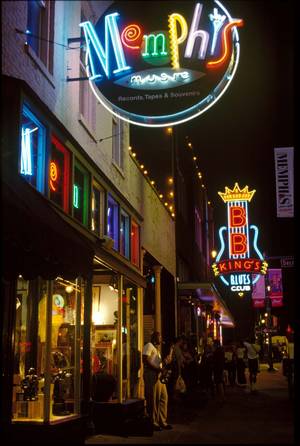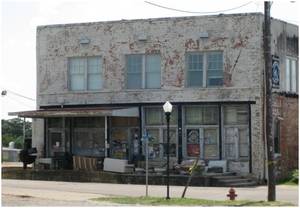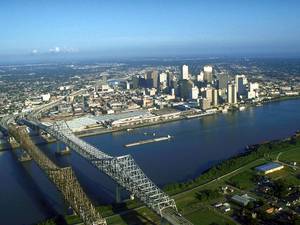Music Along the Mississippi River
Memphis
Our trip along the Mississippi brought us to Memphis. The city is situated in the southwest of the State of Tennessee, south of the confluence of the Wolf and Mississippi rivers. With its 676.000 inhabitants it is the largest city of the state of Tennessee, followed by Nashville, the capital of Tennessee, with 605.000 inhabitants.

Another musical highlight in Memphis is Beale Street. Beale Street is situated in Downtown Memphis and runs from the Mississippi River to East Street. It was created in 1841 by attorney Robertson Topp, who named it after a forgotten military hero, General Beale, whom he met in Washington. The original name of the Beale Street was Beale Avenue. In the beginning, Beale Avenue was divided into two parts: the western end at the Mississippi river, with shops of trade merchants, who traded goods, like cotton wool with ships along the Mississippi river. The eastern part developed as an affluent suburb.
After the Civil War and the abolition of slavery, many African-Americans came to Memphis, especially to Beale Avenue, the former name of the street, because of its various economic opportunities. In the 1860s, the first black travelling musicians began to perform on Beale Avenue and the avenue developed to a melting pot for all kinds of musicians. In 1890 Beale Street underwent renovation and the Grand Opera House was built, today known as the Orpheum.
In the early 1900s clubs, restaurants and shops were added and the owners were African-Americans, those who travelled and performed earlier on the street.
In 1977 Beale Street was officially declared the Home of the Blues by an act of Congress.
Expectation and finally experiencing Beale Street
What can you expect when you come to Beale Street?
Exactly what every travel brochure tells you about this famous Street: right at the beginning of the street we saw a group of African-Americans performing street dances and acrobatic stunts. The street was very crowded and it is not forbidden to take alcoholic beverages with you on the street. At every corner of the street there is a musician or a band playing songs. Blues songs, of course. But we were surprised that there were not as many African-Americans as we thought. Most of the Blues singers were Caucasian the night we went there.
But the visitors of Beale Street presented a lively melting pot. Of course, Memphis is a tourist magnet. Many people come to visit Graceland, the place where Elvis Presley lived and died. Also, many of them want to visit the Home of the Blues as well. But there are also inhabitants of Memphis who come regularly to Beale Street to have a drink, listen to performances and to meet people from all over the world.
You can wander around with a drink in your hand and listen to the music, to saxophones and trumpets. It is a nice atmosphere and people of every skin color and origin celebrate the Home of Blues and the police of Memphis maintains law and order and smiles for tourist photos.
But does the lack of Black musicians on Beale Street affect the authenticity of Blues music on Beale Street?

Delta Blues Museum Clarksdale
The Delta Blues Museum is a cosy little museum housed in the historic Clarksdale freight depot built in the year 1918 for the Yazoo and Mississippi Valley Railroad. It displays a lot of pictures of Blues musicians and their original clothes and instruments. If someone does not know much about Blues music, most of the musicians will be unknown to him or her.
The Delta Blues Museum shows that music really changed on Beale Street. In former times Blues music was only made by Afro-Americans. But nowadays Caucasians also perform Blues music on Beale Street.
Ground Zero Blues Club

New Orleans

We got a completely different impression on our musical tour in New Orleans. More precisely on Bourbon Street, located in the French Quarter.
With 1,2 million inhabitants New Orleans is the largest city in the state of Louisiana.
Its mixed architecture shows Spanish, French, Creole and American influences and it is in fact the only intact French Colonial and Spanish settlement remaining in the U.S. In the heart of the French Quarter is Bourbon Street, a street full of bars, restaurants and clubs. Bourbon Street, also known under the name Rue Bourbon, was named after the former royal family of France.
Conclusion
Our conclusion is that if you want to listen to real Jazz music, Bourbon Street is not the right choice. Nevertheless, in the French Quarter we had the chance to listen to some nice street musicians playing catchy Jazz songs. Also Beale Street and the Delta Blues museum lived up to our expectations and provided an insight into the musical history and its huge influence for the Mississippi Delta.
Author: Silke Schmidt (Univ. d. Saarlandes)
-
 Music_on_the_Mississippi_River.pdf Full Text.
Music_on_the_Mississippi_River.pdf Full Text.